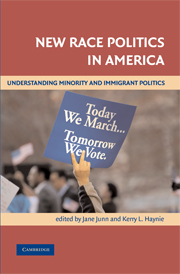Book contents
- Frontmatter
- Contents
- Contributors
- Acknowledgments
- 1 New Race Politics: The Changing Face of the American Electoral Landscape
- 2 In Whose Interest? Political Parties, Context, and the Incorporation of Immigrants
- 3 Beyond Black and White: The Experiences and Effects of Economic Status among Racial and Ethnic Minorities
- 4 Activity amid Diversity: Asian American Political Participation
- 5 Get Me to the Polls on Time: Coethnic Mobilization and Latino Turnout
- 6 Se Habla Espanol: Ethnic Campaign Strategies and Latino Voting Behavior
- 7 Structuring Group Activism: A Macro Model of Black Participation
- 8 Black Elites and Latino Immigrant Relations in a Southern City: Do Black Elites and the Black Masses Agree?
- 9 Understanding the New Race Politics: Conclusions and Challenges
- References
- Index
4 - Activity amid Diversity: Asian American Political Participation
Published online by Cambridge University Press: 05 September 2012
- Frontmatter
- Contents
- Contributors
- Acknowledgments
- 1 New Race Politics: The Changing Face of the American Electoral Landscape
- 2 In Whose Interest? Political Parties, Context, and the Incorporation of Immigrants
- 3 Beyond Black and White: The Experiences and Effects of Economic Status among Racial and Ethnic Minorities
- 4 Activity amid Diversity: Asian American Political Participation
- 5 Get Me to the Polls on Time: Coethnic Mobilization and Latino Turnout
- 6 Se Habla Espanol: Ethnic Campaign Strategies and Latino Voting Behavior
- 7 Structuring Group Activism: A Macro Model of Black Participation
- 8 Black Elites and Latino Immigrant Relations in a Southern City: Do Black Elites and the Black Masses Agree?
- 9 Understanding the New Race Politics: Conclusions and Challenges
- References
- Index
Summary
Despite the fact that Asian Americans have been in the United States for centuries, attention to their political behavior is a strikingly new phenomenon. Asian Americans have been overlooked until recently because of the relatively small size of the population compared with minority groups such as African Americans and Latinos, the residential concentration of Asian Americans in a handful of states, and the perception that Asian Americans are quiescent rather than active in politics. These reasons share common origins in U.S. immigration policy, in particular the Immigration Exclusion Act of 1882, the Immigration Acts of 1917, 1924, and the Tydings-McDuffie Act of 1934, all of which explicitly excluded immigrants from China, Japan, India, and the Philippines, and prohibited citizenship among Asian Americans. In addition, the Alien Land Laws of 1913, 1920, and 1923 barred Asian immigrants from owning land and other forms of property (Takaki 1989; Chan 1991; Ngai 2004; Tichenor 2001). Not until 1952 could Asian Americans become naturalized U.S. citizens.
Although these openly discriminatory statues no longer constitute federal law, immigration and citizenship policy favorable to Asian Americans came only with the reforms enumerated by the 1965 Immigration Act. Indeed, the rapid increase in the Asian American population in the United States is a product of immigration laws that no longer explicitly exclude Asians. Between 1990 and 2000, the Asian American population grew from 6.9 million to 11.9 million, an increase of 72 percent (Barnes and Bennett 2002).
- Type
- Chapter
- Information
- New Race Politics in AmericaUnderstanding Minority and Immigrant Politics, pp. 70 - 94Publisher: Cambridge University PressPrint publication year: 2008
- 5
- Cited by



